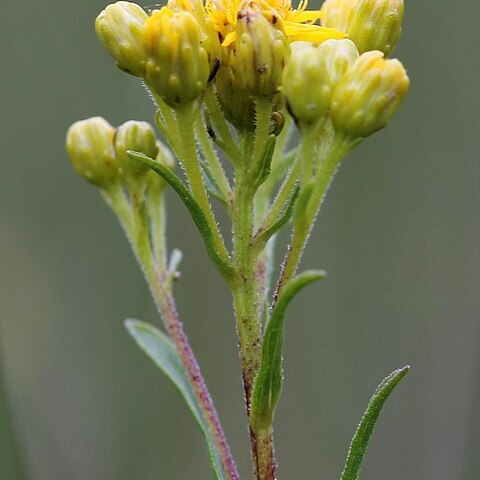Plants 30–60+ cm; caudices branching; vascular bundles and petiole bases marcescent (attached to old stems for more than a season). Stems 1–5+, erect, slender, glabrous. Leaves: basal tapering to long, winged petioles, blades ovate, to 7–22 mm wide, margins entire, apices acute, faces glabrous; proximal cauline tapering to winged petiole-like bases partially clasping stems, blades sometimes 3-nerved (2 prominent lateral nerves arising proximally and running alongside midnerve for some distance before diverging), linear oblanceolate , 158–177 × 7–22 mm, margins entire, ciliate, apices acute to obtuse, glabrous; mid to distal sessile, blades linear lanceolate , mid often 3-nerved (obscurely sometimes), distal 1-nerved, 47–100 × 4–10 mm, reduced distally. Heads (2–)5–50(–100+), not secund, in corymbiform arrays, branches and peduncles glabrous or moderately strigillose. Peduncles 5–6.2 mm, sparsely to moderately strigillose; bracteoles 0–2, linear. Involucres campanulate, (5.5–)6–8(–9) mm. Phyllaries in 3–4 series, unequal, linear to oblanceolate, margins ciliate, weakly striate, obtuse to rounded. Ray florets 6–12 (pale to bright yellow); laminae 7.4–7.9 × 0.5–0.6 mm. Disc florets 8–15; corollas 4–4.3 mm, lobes 0.9–1.5 mm. Cypselae obconic, 1.4–1.8 mm, glabrous, ribs sometimes dark; pappi of bristles 4–5.5 mm, clavate. 2n = 54.
More
Slender perennial from a caudex, 2–5 dm, rough-puberulent in the infl, otherwise glabrous except for the scabro-ciliolate lf-margins; lvs basally disposed, tending to be weakly triple-nerved and often conduplicate, the larger ones linear-oblanceolate to linear, to 20 × 2 cm, the cauline few, 7–15 below the infl; infl corymbiform, its heads crowded, relatively few, mostly less than 50; invol 5.5–8 mm, its bracts firm, blunt, scarcely striate; rays ca 6 and disk-fls ca 13; achenes glabrous, 3–5-angled, the angles weakly nerved; many of the pappus-bristles slightly clavate and subplumose; 2n=54. Swamps and moist beaches, often in moist sandy swales behind the dunes; Genesee Co., N.Y., and along the shores of the n. parts of Lake Michigan and Huron, rarely inland in ne. Mich.


